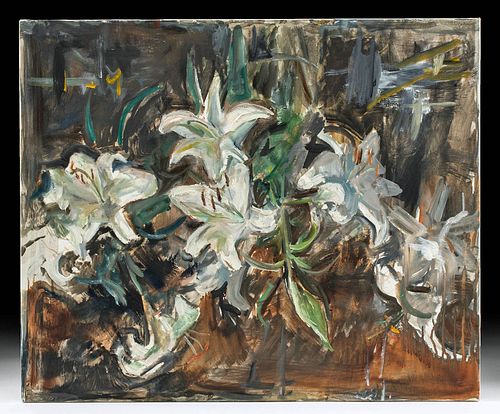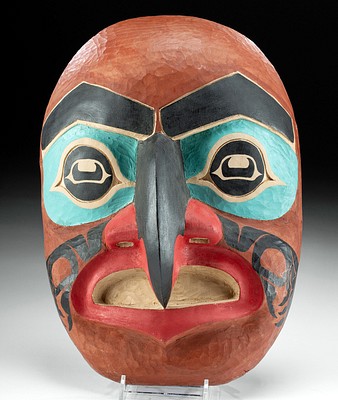William Draper Painting - White Lilies, 1999
Lot 34
About Seller
Artemis Fine Arts
686 S Taylor Ave, Ste 106
Louisville, CO 80027
United States
Selling antiquities, ancient and ethnographic art online since 1993, Artemis Gallery specializes in Classical Antiquities (Egyptian, Greek, Roman, Near Eastern), Asian, Pre-Columbian, African / Tribal / Oceanographic art. Our extensive inventory includes pottery, stone, metal, wood, glass and textil...Read more
Estimate:
$1,300 - $1,950
Absentee vs Live bid
Two ways to bid:
- Leave a max absentee bid and the platform will bid on your behalf up to your maximum bid during the live auction.
- Bid live during the auction and your bids will be submitted real-time to the auctioneer.
Bid Increments
| Price | Bid Increment |
|---|---|
| $0 | $25 |
| $300 | $50 |
| $1,000 | $100 |
| $2,000 | $250 |
| $5,000 | $500 |
| $10,000 | $1,000 |
| $20,000 | $2,500 |
| $50,000 | $5,000 |
| $100,000 | $10,000 |
| $200,000 | $20,000 |
About Auction
By Artemis Fine Arts
Sep 2, 2021
Set Reminder
2021-09-02 12:00:00
2021-09-02 12:00:00
America/New_York
Bidsquare
Bidsquare : Summer Art Auction | Fine | Folk | Fun
https://www.bidsquare.com/auctions/artemis-gallery/summer-art-auction-fine-folk-fun-7395
Featuring visual treats from around the world, and back in time to present day - fine art, folk art, and fun artsy objects. Paintings. Sculptures. Textiles. More. Convenient in-house shipping. Artemis Fine Arts info@artemisgallery.com
Featuring visual treats from around the world, and back in time to present day - fine art, folk art, and fun artsy objects. Paintings. Sculptures. Textiles. More. Convenient in-house shipping. Artemis Fine Arts info@artemisgallery.com
- Lot Description
William Draper (American, 1912-2003). Oil on canvas, 1999. A striking composition of white lilies - also known as Lilium candidum or Madonna Lilies - painted by American artist William Draper. This flower has been cultivated since antiquity - for 3,000 years or more. Many ancient civilizations associated it with deities, and in later times, Christianity upheld the lily as a symbol of the Virgin Mary (see more about this in the extended description below). Draper was an observant nature lover as well as a master of plein air painting. In addition, he was a founder of the American Orchid Society. This composition certainly demonstrates Draper's keen observatory eye, as he not only captured the beauty of these flowers, but also meticulously delineated the anatomy of each bloom. According to the artist's family, this painting was created by Draper in 1999, just prior to undergoing heart surgery. Size: 20" L x 23.75" W (50.8 cm x 60.3 cm)
The lily has been coveted for its symbolism by many ancient civilizations. To the ancient Egyptians, the trumpet-shaped lily symbolized upper Egypt. This flower was also associated with Astarte (also known as Ishtar) goddess of fertility and creation, in the Near East. Furthermore, the ancient Greeks and Romans associated the lily with the queen of the gods, Hera and Juno respectively, as well as the Roman goddess Venus. Later in history, the white lily symbolized chastity in the Catholic Church as well as some Orthodox churches. As a symbol of purity, the lily has been most often associated with the Virgin Mary. For example, depictions of the Annunciation traditionally show the Archangel Gabriel offering the Virgin Mary a white lily, and the flower also has been an attribute of other chaste saints such as Francis of Assissi, Saint Anthony of Padua, and Saint Joseph.
William Draper's career spanned seven decades and his subjects included a portrait of John F. Kennedy that hangs in the National Portrait Gallery in Washington D.C. based upon an oil sketch for which the president sat in 1962. Draper was actually the only artist who painted JFK from life. Draper showed at Knoedler, the Graham Gallery, Portraits, Inc., the Far Gallery, The Findlay Galleries (New York, NY) and the Robert C. Vose Galleries (Boston, MA). His work has been included in shows at the National Portrait Gallery and the Corcoran Gallery of Art (Washington, D.C.), The National Academy of Design (New York, NY), The Boston Museum of Fine Arts, (Boston, MA) the Fogg Art Museum, (one of the Harvard Art Museums, Cambridge, MA), the National Gallery, (London), Salon de la Marine (Paris) and in museums in Australia. He also taught at the Art Students League of New York, and received a lifetime achievement award from the Portrait Society of America in 1999.
More on the artist's background: William Franklin Draper was born in Hopedale, Massachusetts on December 24, 1912. A child prodigy, he studied classical piano at Harvard University. He later changed his focus to fine art and studied with Charles Webster Hawthorne and Henry Hensche in Provincetown, Rhode Island. Draper also attended the National Academy of Design in New York and the Cape Cod School of Art in Massachusetts. Then he traveled to Spain and studied with Harry Zimmerman, moved on to France and attended the Academie de la Grande Chaumiere. In 1937, he moved to Boston to study sculpture with George Demetrius and also studied with Jon Corbino in beautiful Rockport, Massachusetts. In 1942, Draper joined the Navy and served as a combat artist when stationed on the Aleutian Islands and in the South Pacific. He observed and painted battle scenes on Bougainville, Guam, Saipan, and other locations, as well as genre scenes of soldiers who were not engaged in combat but rather at work and at play. National Geographic magazine reproduced 25 of his war images in four issues in 1944. In 1945, the Corcoran Gallery of Art in Washington D.C. organized a group exhibition of works by five official war artists, including Draper. That same year the Metropolitan Museum of Art included Draper in an exhibition entitled, ''The War Against Japan.'' Draper was also featured in a PBS television show about combat artists entitled, "They Drew Fire" in May of 2000. After the war, Draper opened a studio on Park Avenue in New York City and continued to not only paint, but also play classical and jazz piano.
Provenance: The William F. Draper Collection, New York City, USA, acquired via descent from the late William Franklin Draper (1912-2003)
All items legal to buy/sell under U.S. Statute covering cultural patrimony Code 2600, CHAPTER 14, and are guaranteed to be as described or your money back.
A Certificate of Authenticity will accompany all winning bids.
PLEASE NOTE: Due to recent increases of shipments being seized by Australian & German customs (even for items with pre-UNESCO provenance), we will no longer ship most antiquities and ancient Chinese art to Australia & Germany. For categories of items that are acceptable to ship to Australia or Germany, please contact us directly or work with your local customs brokerage firm.
Display stands not described as included/custom in the item description are for photography purposes only and will not be included with the item upon shipping.
#152330The painting is in overall excellent condition, and there is a Draper Estate stamp on the verso.Condition
- Shipping Info
-
All shipping is handled in-house for your convenience. Your invoice from Artemis Gallery will include shipping calculation instructions. If in doubt, please inquire BEFORE bidding for estimated shipping costs for individual items.
-
- Buyer's Premium



 EUR
EUR CAD
CAD AUD
AUD GBP
GBP MXN
MXN HKD
HKD CNY
CNY MYR
MYR SEK
SEK SGD
SGD CHF
CHF THB
THB














